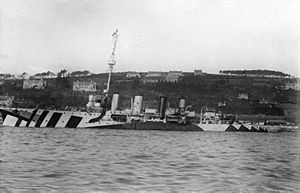Active-class cruiser
This article includes a list of references, related reading, or external links, but its sources remain unclear because it lacks inline citations. (January 2013) |

| |
| Class overview | |
|---|---|
| Name | Active |
| Operators | |
| Preceded by | Blonde class |
| Succeeded by | Arethusa class |
| In commission | 1911 - 1921 |
| Completed | Three |
| Lost | One |
| General characteristics | |
| Type | scout cruiser |
| Displacement | list error: <br /> list (help) 3,440 tons normal 4,000 tons deep load |
| Length | list error: <br /> list (help) 385 ft (117.3 m) (p/p) 406 ft (123.7 m) (o/a) |
| Beam | 41 ft 6 in (12.65 m) |
| Draught | 15 ft 7 in (4.75 m) |
| Propulsion | list error: <br /> list (help) 12 Yarrow boilers Parsons turbines Four shafts 18,000 shp (13,423 kW) |
| Speed | 25 knots (46.3 km/h) |
| Range | list error: <br /> list (help) Carried 350 tons coal (780 tons max) 190 tons fuel oil |
| Complement | 321-325 |
| Armament | list error: <br /> list (help) 10 x BL 4-inch (101.6 mm) Mk VII guns (10 x 1), (Fearless carried eight) One 3-inch (76-mm) Anti-aircraft gun |
| Armour | list error: <br /> list (help) conning tower: 4 inch deck: 1 inch |
The Active class was a class of three scout cruisers of the Royal Navy, built prior to the First World War, and later seeing service in that conflict. The three ships that made up the class were HMS Active, HMS Amphion and HMS Fearless.
Description
They were the last class of scout cruiser built for the Royal Navy, as their role was increasingly being taken over by the light cruisers, the first of which, the Town class, were beginning to enter service. The Active class was a follow on from the design of the previous Blonde class scouts, with the main visible difference being the 'plough' bow shape. They also retained the limited protection with plating only covering the machinery spaces. They were ordered under the 1911 Naval estimates and built throughout 1910 and 1911, at Pembroke Dockyard, entering service just before the outbreak of the First World War. The last ship to be built, HMS Fearless, underwent modifications before launching, which included the removal of two 4-inch (102 mm) guns and the addition of a 3-inch (76.2 mm) anti-aircraft guns as well as additional search lights.
Service
All three ships started the war with the Harwich Force, and saw action in a number of engagements, with HMS Amphion becoming the first ship of the Royal Navy lost in the war, when she was sunk by a mine on 6 August 1914. Fearless later became leader of a squadron of the notoriously accident prone K class steam submarines, accidentally ramming and sinking HMS K17 in January 1918.
Already considered obsolete as the war was drawing to a close, the two survivors were sold for scrapping in the early 1920s.
See also
This section is empty. You can help by adding to it. (February 2013) |
References
- Colledge, J. J.; Warlow, Ben (2006) [1969]. Ships of the Royal Navy: The Complete Record of all Fighting Ships of the Royal Navy (Rev. ed.). London: Chatham Publishing. ISBN 978-1-86176-281-8.
- Jane's Fighting Ships of World War One (1919), Jane's Publishing Company
- Active class in World War I
